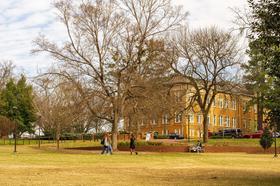Top Rankings
Belton Independent School District ranks among the top 20% of public school district in Texas for:
Category
Attribute
Graduation Rate
Highest graduation rate (Top 20%)
Diversity
Most diverse schools (Top 1%)
Community Size
Largest student body (number of students) (Top 1%)
For the 2025-26 school year, there is 1 public preschool serving 519 students in Belton Independent School District.
Public Preschools in Belton Independent School District have a diversity score of 0.67, which is more than the Texas public preschool average of 0.63.
Minority enrollment is 64% of the student body (majority Hispanic), which is less than the Texas public preschool average of 76% (majority Hispanic).
Overview
This School District
This State (TX)
# Schools
21 Schools
4,185 Schools
# Students
13,808 Students
2,148,412 Students
# Teachers
981 Teachers
147,701 Teachers
Student-Teacher Ratio
14:1
14:1
District Rank
Belton Independent School District, which is ranked #544 of all 1,196 school districts in Texas (based off of combined math and reading proficiency testing data) for the 2022-2023 school year.
The school district's graduation rate of 92% has decreased from 95% over five school years.
Overall District Rank
#546 out of 1202 school districts
(Top 50%)
(Top 50%)
Math Test Scores (% Proficient)
41%
44%
Reading/Language Arts Test Scores (% Proficient)
53%
51%
Science Test Scores (% Proficient)
49%
46%
Graduation Rate
92%
90%
Students by Ethnicity:
Diversity Score
0.64
0.63
% American Indian
n/a
n/a
% Asian
2%
5%
% Hispanic
36%
55%
% Black
8%
13%
% White
48%
24%
% Hawaiian
n/a
n/a
% Two or more races
6%
3%
All Ethnic Groups
District Revenue and Spending
The revenue/student of $11,934 in this school district is less than the state median of $13,398. The school district revenue/student has declined by 8% over four school years.
The school district's spending/student of $11,556 is less than the state median of $14,129. The school district spending/student has declined by 8% over four school years.
Total Revenue
$165 MM
$74,029 MM
Spending
$160 MM
$78,063 MM
Revenue / Student
$11,934
$13,398
Spending / Student
$11,556
$14,129
Best Belton Independent School District Public Preschools (2025-26)
School
(Math and Reading Proficiency)
(Math and Reading Proficiency)
Location
Quick Facts
Rank: n/an/a
501 E 4th
Belton, TX 76513
(254) 215-3700
Belton, TX 76513
(254) 215-3700
Gr: PK | 519 students Student-teacher ratio: 19:1 Minority enrollment: 64%
Recent Articles

School Vouchers 2025: Updated Pros and Cons
A 2025 update on school vouchers, including benefits, drawbacks, enrollment trends, and how vouchers affect public and private education.

The Role of Arts in Public Schools (2025 Update)
Explore why arts education remains vital in U.S. public schools, with updated data, new policy context, and insights for parents, students, and educators.

The Role of Sports in Public Schools in 2025
How sports in public schools shape learning, health, and community in 2025, with updated data, trends, and expert insights.





